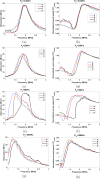Probing the pressure dependence of sound speed and attenuation in bubbly media: Experimental observations, a theoretical model and numerical calculations
- PMID: 36931196
- PMCID: PMC11487347
- DOI: 10.1016/j.ultsonch.2023.106319
Probing the pressure dependence of sound speed and attenuation in bubbly media: Experimental observations, a theoretical model and numerical calculations
Abstract
The problem of attenuation and sound speed of bubbly media has remained partially unsolved. Comprehensive data regarding pressure-dependent changes of the attenuation and sound speed of a bubbly medium are not available. Our theoretical understanding of the problem is limited to linear or semi-linear theoretical models, which are not accurate in the regime of large amplitude bubble oscillations. Here, by controlling the size of the lipid coated bubbles (mean diameter of ≈5.4μm), we report the first time observation and characterization of the simultaneous pressure dependence of sound speed and attenuation in bubbly water below, at and above microbubbles resonance (frequency range between 1-3 MHz). With increasing acoustic pressure (between 12.5-100 kPa), the frequency of the peak attenuation and sound speed decreases while maximum and minimum amplitudes of the sound speed increase. We propose a nonlinear model for the estimation of the pressure dependent sound speed and attenuation with good agreement with the experiments. The model calculations are validated by comparing with the linear and semi-linear models predictions. One of the major challenges of the previously developed models is the significant overestimation of the attenuation at the bubble resonance at higher void fractions (e.g. 0.005). We addressed this problem by incorporating bubble-bubble interactions and comparing the results to experiments. Influence of the bubble-bubble interactions increases with increasing pressure. Within the examined exposure parameters, we numerically show that, even for low void fractions (e.g. 5.1×10-6) with increasing pressure the sound speed may become 4 times higher than the sound speed in the non-bubbly medium.
Keywords: Attenuation; Cavitation; Microbubbles; Nonlinear Dynamics; Sound Speed.
Copyright © 2023 The Author(s). Published by Elsevier B.V. All rights reserved.
Conflict of interest statement
Declaration of Competing Interest The authors declare that they have no known competing financial interests or personal relationships that could have appeared to influence the work reported in this paper.
Figures
















References
-
- Suslick K.S. Sonochemistry. Science. 1990;247(4949):1439–1445. - PubMed
-
- Mantouka A., Dogan H., White P.R., Leighton T.G. Modelling acoustic scattering, sound speed, and attenuation in gassy soft marine sediments. The journal of the acoustical society of America. 2016;140(1):274–282. - PubMed
-
- Etter P.C. CRC Press; 2013. Underwater acoustic modeling and simulation.
-
- Leighton T.G., Dogan H., Fox P., Mantouka A., Best A.I., Robb G.B., White P.R. Acoustic propagation in gassy intertidal marine sediments: An experimental study. The Journal of the Acoustical Society of America. 2021;150(4):2705–2716. - PubMed
-
- Maisonhaute E., Prado C., White P.C., Compton R.G. Surface acoustic cavitation understood via nanosecond electrochemistry. Part III: Shear stress in ultrasonic cleaning. Ultrasonics sonochemistry. 2002;9(6):297–303. - PubMed
LinkOut - more resources
Full Text Sources

